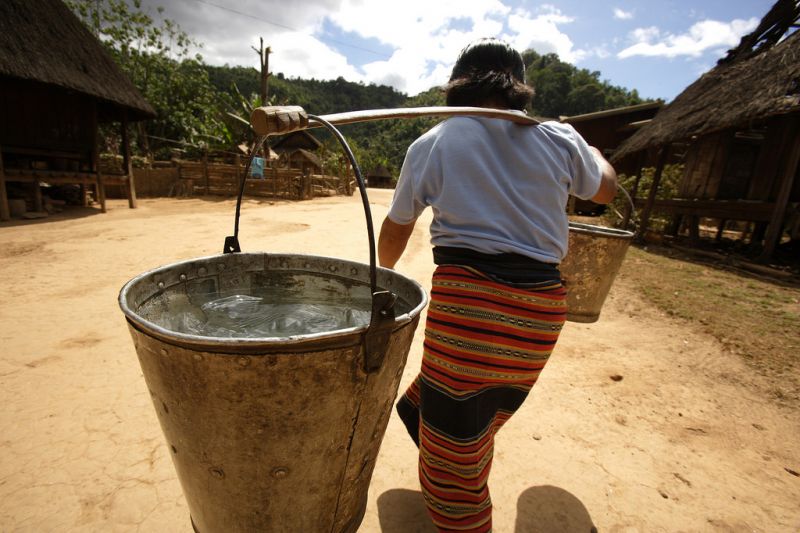Quantifying Gender & Sex Inequities In WASH
Published on by Libbet Loughnan, Advisor, International WASH Indicators at World Bank in Social
The Sustainable Development Goals (SDGs) acknowledge that women and girls have unique WASH-related circumstances. Data and indicators are critical for quantifying issues, informing stakeholders, and in finding sustainable WASH solutions. But we are struggling with a global lack of monitoring.
In fact, the wording of Goal 6 Target 6.2 is “By 2030, achieve access to adequate and equitable sanitation and hygiene for all and end open defecation, paying special attention to the needs of women and girls and those in vulnerable situations”.

The paper “ What can existing data on water and sanitation tell us about menstrual hygiene management ?” was short-listed last week in Waterlines’ Jeroen Ensink Memorial Prize, commemorating the efforts of Dr. Ensink to improve the lives of those who today still live without access to safe drinking water and sanitation.
We write this blog to try to get the measurements and concepts expressed in the paper, as well as an update on some more recent developments, out to a bigger audience that might find them useful.
Indirect measures
The paper helped establish the possible use of the handwashing and open defecation estimates long collected by the UNICEF Multiple Indicator Cluster Surveys (MICS) and Demographic and Health Surveys (DHS), and calculated and disseminated by the WHO/UNICEF Joint Monitoring Programme for Water Supply and Sanitation (JMP), for quantifying gender and sex inequities in an internationally comparable manner for the first time.
Through such data, we can understand that any menstruating women among them likely have a less private and more stressed WASH experience than their counterpart males (and their menstruating counterpart WASH-supplied counterparts). The article presented global estimates as well as national for 10 case study countries among the World Bank’s WASH Poverty Diagnostic.
Some headline findings were as follows:
Half a billion women, or 13% of all women: Approximate number, and percent, of women globally who lack a place to defecate and likely lack privacy for MHM.
197: Number of countries for which such estimates were available in 2015.
6/10: Data on handwashing suggests by proxy that lack of cleansing materials is a particular challenge for MHM. In six of ten study countries with data, over three quarters of women lacked cleansing materials.
54: Number of countries for which such estimates were available in 2015.
Our research is also stretching into other widely available data, for example information on the location, exclusivity, and type of latrines.
Direct measures
More direct measurements are also desirable, and in recent months the MICS have started rolling out new measurements for women post-menarche, as follows.
- When did your last menstrual period start?
- Was the last menstrual period within last year?
- Due to your last menstruation, were there any social activities, school or work days that you did not attend?
- During your last menstrual period were you able to wash and change in privacy while at home?
- Did you use any materials such as sanitary pads, tampons or cloth?
- Were the materials reusable?
In coming years they will be available for multiple countries.
Indirect and direct measurements in institutional settings
Under the SDGs the JMP plans to shine a light on the WASH situation of schools and health care settings as well, as places that should be equipped as if they absorb a great deal of one’s lifetime and critical moments.
Future developments
The sooner we can roll more comprehensive quantitative assessments and monitoring out the better, in case it represents some simple keys to some complex issues.
Looking to the bigger picture, it is worth noting that while some of the estimates mentioned here might help build an international picture of where and how gender and sex-based inequities exist, they still look just at the WASH domain. We will also be working to explore what else these large-scale surveys may offer to quantify the knock-on effects or interrelationship with broader elements of life.
This blog draws particularly on research by Libbet Loughnan and Rosemary Rop (World Bank), Tom Slaymaker and Rob Bain (WHO/UNICEF Joint Monitoring Programme for Water Supply and Sanitation (JMP)), and Marni Sommer (Columbia University)
- The mentioned paper can be found at:
http://www.developmentbookshelf.com/doi/full/10.3362/1756-3488.2016.019 ·The MICS questions can be found in the “Questionnaire for Individual Women (24 February 2017)” at :http://mics.unicef.org/tools?round=mics6
- The questions recommended by the JMP for contributing to global monitoring in institutional settings can be found at:
https://www.wssinfo.org/documents/?tx_displaycontroller[type]=reference_documents
Media
Taxonomy
- Gender Equality
- Sanitation
- Data Management
- Water & Sanitation
- Sanitation & Hygiene
- Water Sanitation & Hygiene (WASH)
- Data Analysis
- Millennium Development Goals (MDG) Sustainable Development Goals (SDG)